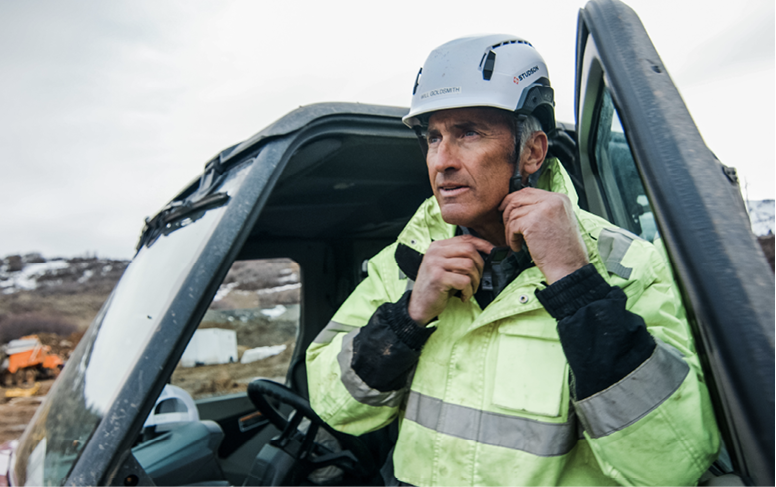How some forward-thinking operators are discovering the improvement in safety and costs that can come from the emergence of smart PPE technology.

A mining operation’s daily startup process remains critical and time-intensive to ensure the safety of those entering; teams and safety managers often begin their mornings managing extensive documentation, from verifying current certifications to reviewing equipment inspection records, often navigating between physical files, spreadsheets, and disconnected digital systems. The process becomes particularly complex when also onboarding new employees, with safety managers having to manually process safety credentials and apply identification markers to personal protective equipment (PPE), a procedure that can take hours. While the process is thorough, it can create substantial administrative overhead as teams work to maintain compliance and ensure worker protection.
Every minute of operational downtime in mining has significant cost implications, and such essential and conventional safety processes highlight hidden inefficiency throughout the organization. Yet, safety adherence is critical. Mining continues to be one of the world’s most dangerous industrial environments, and observing safety protocols can mean the difference between life and death – and potentially significant insurance claims that can cost companies millions.
Challenges of PPE management in mining
OSHA’s PPE standards under 29 CFR 1926.95 and MSHA’s under 56/57.15006 mandate that employers not only provide appropriate PPE, but also ensure its proper maintenance and reliable distribution tracking. However, the challenges of managing PPE across large-scale mining operations extend far beyond simple inventory control. Traditional tracking methods rely heavily on manual processes – from recording handwritten serial numbers to maintaining multiple spreadsheets for compliance documentation.
While some updates, like basic QR codes affixed to helmets, have attempted to bridge the digital gap, their limited capabilities often create more complexity than relief. Equipment inspections, crucial for safety and compliance, frequently face delays as safety teams locate specific items, verify maintenance histories, and records are updated across disparate, siloed systems. When multiplied across hundreds or thousands of pieces of PPE, from harnesses to helmets, these inefficiencies create significant managerial burdens and potential compliance risks.
For safety teams already managing complex daily operations, the time spent on PPE tracking and certificate verification represents a substantial opportunity that impacts site-wide productivity.
The emergence of smart PPE
New smart PPE technology has gained attention across industries, including mining, as it represents a shift in how operational teams can manage safety equipment and compliance requirements. Safety helmets and harnesses now come integrated with near-field communication (NFC) technology, enabling organizations to transform basic safety gear into connected assets manageable by modern enterprise software systems. Safety managers use a smartphone app to scan the PPE to digitize inventory tracking, eliminating labor-intensive record keeping while providing real-time visibility into equipment status, inspections, and replacement timing.
When equipment is digitized and connected with safety management software, managers can simplify routine yet important tasks, such as sending reminders to employees to inspect their PPE or that their equipment is due for replacement. This digital transformation particularly aids in tracking MSHA and OSHA compliance, automating documenting compliance checks, and allowing managers to connect with employees who fail to conduct their inspections. When integrated with organizational software platforms, safety teams can create a digital thread that reduces administrative tasks and helps prevent the use of expired or compromised safety equipment. This provides safety managers with visibility into their entire workforce in a single, integrated system.
Digital storage vs. paperwork
Integrating digital storage capabilities within smart PPE extends beyond basic equipment inventory tracking. NFC-enabled devices also serve as a secure digital repository of vital worker information, from current certifications and training records to critical medical data such as allergies, pre-existing conditions like heart issues or diabetes, and personal emergency contact details. Creating a comprehensive digital profile becomes crucial during emergencies, where immediate access to accurate information can significantly impact response effectiveness.
Rather than waiting for medical histories to be retrieved from HR systems or relying on potentially incomplete verbal reports during an emergency, responders have immediate access to verified medical information that could prove life-saving. Instant accessibility transforms emergency response capabilities at mining sites, where the combination of remote locations and high-risk operations makes rapid access to accurate worker information particularly vital.

Smart PPE considerations
The business case for smart PPE extends well beyond safety improvements, delivering measurable returns that justify the added investment. Equipment loss and premature replacement, which can cost sites hundreds of thousands of dollars annually, see significant reductions through improved tracking and routine inspections. Additionally, insurance providers are beginning to recognize smart PPE implementation as a risk reduction measure, potentially leading to lower premiums.
With smart PPE housing and centralizing key workplace documents and certifications, daily check-in processes are simplified, streamlining morning operations and getting workers on site faster.
Some mining organizations have made strides in digitizing their operations, where workers receive radio frequency identification (RFID) tags that, much like NFC chips, store personal information and documentation. However, in some cases, workers must attach credentials to their equipment or store them in their overalls or base-layer pockets, hoping they do not get lost. Integrating them into assigned PPE is much more practical and efficient for tracking purposes and loss prevention.
Mining companies that delay modernizing their safety management technology face significant operational and financial consequences. The lack of data-driven insights across an operation hampers productivity and workforce deployment decisions, while outdated systems can frustrate employees and make it harder to attract workers. Modernization is a competitive necessity in an industry where safety and operational excellence are inseparable. The benefits extend beyond efficiency gains and can foster a stronger safety culture where technology enables better decision-making and faster emergency response.
Forward-thinking operations are discovering that transitioning to smart PPE management delivers measurable improvements in safety outcomes while reducing administrative costs and strengthening regulatory compliance and overall operational efficiency. As the mining industry evolves, operators must evaluate their current safety systems and consider how smart PPE integration aligns with their commitment to worker protection and operational excellence.
About the author: Christian Connolly is the CEO of global wearable safety technology firm Twiceme. opportunity that impacts site-wide productivity.
